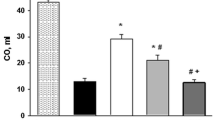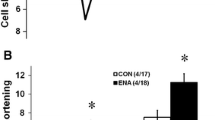Abstract
We previously reported that MET-88, 3-(2,2,2-trimethylhydrazinium) propionate, improved left ventricular diastolic dysfunction induced by congestive heart failure (CHF) in rats. The present study was designed to investigate the mechanism by which MET-88 improved the cardiac relaxation impaired in CHF rats. The left coronary artery of the animals was ligated, and the rats were then orally administered vehicle (control), MET-88 at 50 or 100 mg/kg or captopril at 20 mg/kg for 20 days. Myocytes were isolated from the non-infarcted region in the left ventricle, and cell shortening and [Ca2+]i transients were measured with a video-edge detector and by fluorescence analysis, respectively. In CHF control rats, the diastolic phase of cell shortening was prolonged compared with that of the sham-operated (sham) rats. This prolongation was prevented by treatment with MET-88 at 100 mg/kg or captopril at 20 mg/kg. CHF control rats also showed an increase in the decay time of [Ca2+]i transients compared with sham rats. MET-88 at 100 mg/kg and captopril at 20 mg/kg attenuated the increase in decay time of [Ca2+]i transients. Ca2+ uptake activity of the sarcoplasmic reticulum (SR) isolated from the non-infarcted region in the left ventricle was measured, and Lineweaver-Burk plot analysis of the activity was performed. CHF control rats revealed a decrease in the Vmax for SR Ca2+ uptake activity without alteration in Kd. MET-88 at 100 mg/kg significantly prevented the decrease in Vmax, but had no effect on Kd. Also, treatment with MET-88 at 100 mg/kg improved myocardial high-energy phosphate levels impaired in CHF rats. These results suggest that one of the mechanisms by which MET-88 improved cardiac relaxation in CHF rats is based on the amelioration of [Ca2+]i transients through increase of SR Ca2+ uptake activity.
Similar content being viewed by others
References
Barry WH, Bridge JH: Intracellular calcium homeostasis in cardiac myocytes. Circulation 87: 1806-1815, 1993
Mercadier JJ, Lompre AM, Duc P, Boheler KR, Fraysse JB, Wisnewsky C, Allen PD, Komajda M, Schwartz K: Altered sarcoplasmic reticulum Ca2+-ATPase gene expression in the human ventricle during end-stage heart failure. J Clin Invest 85: 305-309, 1990
Takahashi T, Allen PD, Lacro RV, Marks AR, Dennis AR, Schoen FJ, Grossman W, Marsh JD, Izumo S: Expression of dihydropyridine receptor (Ca2+ channel) and calsequestrin genes in the myocardium of patients with end-stage heart failure. J Clin Invest 90: 927-935, 1992
Arai M, Alpert NR, MacLennan DH, Barton P, Periasamy M: Alterations in sarcoplasmic reticulum gene expression in human heart failure. A possible mechanism for alterations in systolic and diastolic properties of the failing myocardium. Circ Res 72: 463-469, 1993
Hasenfuss G, Reinecke H, Studer R, Meyer M, Pieske B, Holtz J, Holubarsch C, Posival H, Just H, Drexler H: Relation between myocardial function and expression of sarcoplasmic reticulum Ca2+-ATPase in failing and non-failing human myocardium. Circ Res 75: 434-442, 1994
Meyer M, Schillinger W, Pieske B, Holubarsch C, Heilmann C, Posival H, Kuwajima G, Mikoshiba K, Just H, Hasenfuss G: Alterations of sarcoplasmic reticulum proteins in failing human dilated cardiomyopathy. Circulation 92: 778-784, 1995
Anger M, Lambert F, Chemla D, Desche P, Scalbert E, Lompre AM, Lecarpentier Y: Sarcoplasmic reticulum Ca2+ pumps in heart and diaphragm of cardiomyopathic hamster: Effects of perindopril. Am J Physiol 268: H1947-H1953, 1995
Zarain-Herzberg A, Afzal N, Elimban V, Dhalla NS: Decreased expression of cardiac sarcoplasmic reticulum Ca2+-pump ATPase in congestive heart failure due to myocardial infarction. Mol Cell Biochem 163-164: 285-290, 1996
Gupta RC, Shimoyama H, Tanimura M, Nair R, Lesch M, Sabbah HN: SR Ca2+-ATPase activity and expression in ventricular myocardium of dogs with heart failure. Am J Physiol 273: H12-H18, 1997
McCall E, Ginsburg KS, Bassani RA, Shannon TR, Qi M, Samarel AM, Bers DM: Ca flux, contractility, and excitation-contraction coupling in hypertrophic rat ventricular myocytes. Am J Physiol 274: H1348-H1360, 1998
Qi M, Shannon TR, Euler DE, Bers DM, Samarel AM: Downregulation of sarcoplasmic reticulum Ca2+-ATPase during progression of left ventricular hypertrophy. Am J Physiol 272: H2416-H2424, 1997
Hayashi Y, Kirimoto K, Asaka N, Miyake H: Beneficial effect of MET-88, a new cardioprotective agent, on ventricular remodeling in rats with chronic heart failure secondary to myocardial infarction. Jpn J Pharmacol 67: 124P, 1995
Aoyagi T, Sugiura S, Eto Y, Yonekura K, Matsumoto A, Yokoyama I, Kobayakawa N, Omata M, Kirimoto T, Hayashi Y, Momomura S: Inhibition of carnitine synthesis protects against left ventricular dysfunction in rats with myocardial ischemia. J Cardiovasc Pharmacol 30: 468-474, 1997
Zarain-Herzberg A, Rupp H, Elimban V, Dhalla NS: Modification of sarcoplasmic reticulum gene expression in pressure overload cardiac hypertrophy by etomoxir. FASEB J 10: 1303-1309, 1996
Simkhovich BZ, Shutenko ZV, Meirena DV, Khagi KB, Mezapuke RJ, Molodchina TN, Kalvins IJ, Lukevics E: 3-(2,2,2-Trimethylhydrazinium) propionate (THP)–a novel gamma-butyrobetaine hydroxylase inhibitor with cardioprotective properties. Biochem Pharmacol 37: 195-202, 1988
Asaka N, Muranaka Y, Kirimoto T, Miyake H: Cardioprotective profile of MET-88, an inhibitor of carnitine synthesis, and insulin during hypoxia in isolated perfused rat hearts. Fundam Clin Pharmacol 12: 158-163, 1998
Selye H, Bajusz E, Grasso S, Mendell P: Simple techniques for the surgical occlusion of coronary vessels in the rat. Angiology 11: 398-407, 1960
Johns TNP, Olson BJ: Experimental myocardial infarction I. A method of coronary occlusion in small animals. Ann Surg 140: 675-682, 1954
Genka C, Ishida H, Ichimori K, Hirota Y, Tanaami T, Nakazawa H: Visualization of biphasic Ca2+ diffusion from cytosol to nucleus in contracting adult rat cardiac myocytes with an ultra-fast confocal imaging system. Cell Calcium 25: 199-208, 1999
Ishida H, Genka C, Hirota Y, Hamasaki Y, Nakazawa H: Distinct roles of peroxynitrite and hydroxyl radical in triggering stunned myocardium-like impairment of cardiac myocytes in vitro. Mol Cell Biochem 198: 31-38, 1999
Yoshida Y, Shiga T, Imai S: Degradation of sarcoplasmic reticulum calcium-pumping ATPase in ischemic-reperfused myocardium: Role of calcium-activated neutral protease. Basic Res Cardiol 85: 495-507, 1990
Afzal N, Dhalla NS: Differential changes in left and right ventricular SR calcium transport in congestive heart failure. Am J Physiol 262: H868-H874, 1992
Sanbe A, Tanonaka K, Hanaoka Y, Katoh T, Takeo S: Regional energy metabolism of failing hearts following myocardial infarction. J Mol Cell Cardiol 25: 995-1013, 1993
Sellevold OF, Jynge P, Aarstad K: High performance liquid chromatography: A rapid isocratic method for determination of creatine compounds and adenine nucleotides in myocardial tissue. J Mol Cell Cardiol 18: 517-527, 1986
Dhalla NS, Kaura D, Liu X, Beamish RE: Mechanisms of subcellular remodelling in post-infarct heart failure. Exs 76: 463-477, 1996
Swynghedauw B: Molecular mechanisms of myocardial remodeling. Physiol Rev 79: 215-262, 1999
Yamaguchi F, Sanbe A, Takeo S: Effects of long-term treatment with trandolapril on sarcoplasmic reticulum function of cardiac muscle in rats with chronic heart failure following myocardial infarction. Br J Pharmacol 123: 326-334, 1998
Liu X, Sentex E, Golfman L, Takeda S, Osada M, Dhalla NS: Modification of cardiac subcellular remodeling due to pressure overload by captopril and losartan. Clin Exp Hypertens 21: 145-156, 1999
Childs TJ, Adams MA, Mak AS: Regression of cardiac hypertrophy in spontaneously hypertensive rats by enalapril and the expression of contractile proteins. Hypertension 16: 662-668, 1990
Nakano M, Kirimoto T, Asaka N, Hayashi Y, Kanno T, Miyake H, Matsuura N: Beneficial effects of MET-88 on left ventricular dysfunction and hypertrophy with volume overload in rats. Fundam Clin Pharmacol 13: 521-526, 1999
Bassani JW, Bassani RA, Bers DM: Relaxation in rabbit and rat cardiac cells: Species-dependent differences in cellular mechanisms. J Physiol (London) 476: 279-293, 1994
Yonekura K, Aoyagi T, Etoh Y, Matsumoto A, Yokoyama I, Kirimoto T, Hayashi Y, Sugiura S, Momomura S, Yazaki Y: Inhibition of carnitine synthesis modulates alterations in protein level and activity of the cardiac hexokinase II in rats with myocardial infarction. Jpn Circ J 63: 129, 1999
He H, Giordano FJ, Hilal-Dandan R, Choi DJ, Rockman HA, McDonough PM, Bluhm WF, Meyer M, Sayen MR, Swanson E, Dillmann WH: Overexpression of the rat sarcoplasmic reticulum Ca2+ ATPase gene in the heart of transgenic mice accelerates calcium transients and cardiac relaxation. J Clin Invest 100: 380-389, 1997
Giordano FJ, He H, McDonough P, Meyer M, Sayen MR, Dillmann WH: Adenovirus-mediated gene transfer reconstitutes depressed sarcoplasmic reticulum Ca2+-ATPase levels and shortens prolonged cardiac myocyte Ca2+ transients. Circulation 96: 400-403, 1997
Opie LH: In: The Heart: Physiology and Metabolism, 2nd edn. Raven Press, 1991, pp 208-246
Dhar PK, Grupp IL, Schwartz A, Grupp G, Matlib MA: Reduction in carnitine content by inhibition of its biosynthesis results in protection of isolated guinea pig hearts against hypoxic damage. J Cardiovasc Pharmacol Ther 1: 235-242, 1996
Hanaki Y, Sugiyama S, Ozawa T: Effect of 3-(2,2,2-trimethylhydrazinium) propionate, gamma-butyrobetaine hydroxylase inhibitor, on isoproterenol-induced mitochondrial dysfunction. Res Commun Chem Pathol Pharmacol 64: 157-160, 1989
Jeremy RW, Koretsune Y, Marban E, Becker LC: Relation between glycolysis and calcium homeostasis in postischemic myocardium. Circ Res 70: 1180-1190, 1992
Nakamura K, Kusuoka H, Ambrosio G, Becker LC: Glycolysis is necessary to preserve myocardial Ca2+ homeostasis during betaadrenergic stimulation. Am J Physiol 264: H670-H678, 1993
Xu KY, Zweier JL, Becker LC: Functional coupling between glycolysis and sarcoplasmic reticulum Ca2+ transport. Circ Res 77: 88-97, 1995
Xu KY, Becker LC: Ultrastructural localization of glycolytic enzymes on sarcoplasmic reticulum vesicles. J Histochem Cytochem 46: 419-427, 1998
Eistetter K, Wolf HPO: Etomoxir. Drugs Future 11: 1034-1036, 1986
Lopaschuk GD, Wall SR, Olley PM, Davies NJ: Etomoxir, a carnitine palmitoyltransferase I inhibitor, protects hearts from fatty acid-induced ischemic injury independent of changes in long chain acylcarnitine. Circ Res 63: 1036-1043, 1988
Lopaschuk GD, McNeil GF, McVeigh JJ: Glucose oxidation is stimulated in reperfused ischemic hearts with the carnitine palmitoyltransferase 1 inhibitor, Etomoxir. Mol Cell Biochem 88: 175-179, 1989
Author information
Authors and Affiliations
Rights and permissions
About this article
Cite this article
Hayashi, Y., Ishida, H., Hoshiai, M. et al. MET-88 a γ-butyrobetaine hydroxylase inhibitor, improves cardiac SR Ca2+ uptake activity in rats with congestive heart failure following myocardial infarction. Mol Cell Biochem 209, 39–46 (2000). https://doi.org/10.1023/A:1007093926315
Issue Date:
DOI: https://doi.org/10.1023/A:1007093926315




